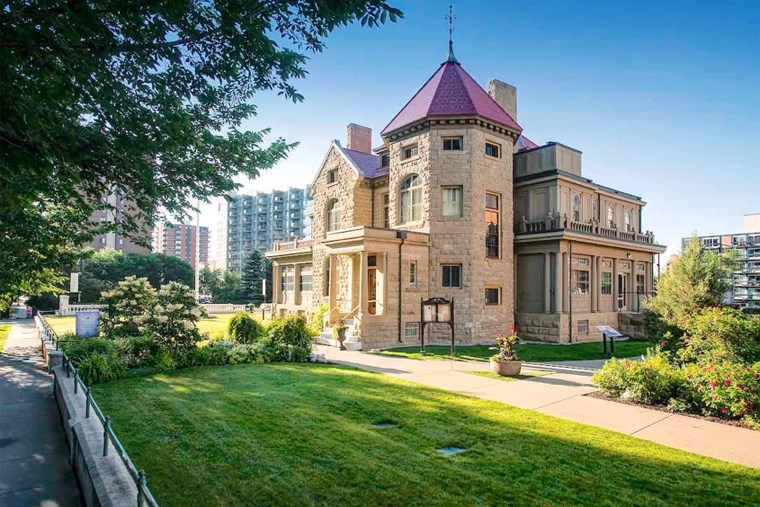Just because we can’t visit Calgary’s historic Lougheed House until it can safely open doesn’t mean we can’t take in its valuable, complex history from home. Whether it’s the pandemic or geography keeping us away, the home’s caretakers are bringing its history to us through online virtual and 3-D experiences. It’s a new avenue tourists can take into many of Alberta’s historic sites today.
“We often associate learning about history and finding a city exciting when we’re tourists somewhere else,” says Holleay Rohm, Lougheed House’s programs manager. “We can gloss over our local history where we’re pedestrians every day. These [virtual experiences] give Calgarians, and others, the opportunity to be a tourist within our own city.”
Anyone wanting to virtually visit Lougheed House can access it by simply downloading the CLIO app. “We’ve got our virtual tour of our house with its audio guide up on the app,” says Rohm. “People can follow along with this while doing the 3-D tour accessed through our website.”
Also available online are several historic walking tours of Calgary’s Beltline community. Narrated by author Shaun Hunter, these tours explore Calgary based upon the perspectives of historic writers from the area. “It’s a step back into a moment in time,” says Rohm. “Tourists see the city through these writers’ eyes and get to be involved in the crossover of their relationships.”
Step Back into a Moment in Time at Lougheed House
Built in 1891, the 14,000 square-foot mansion built of sandstone was home to Senator Sir James Alexander Lougheed and his wife Lady Isabella Clark Lougheed. Raising their family here, the couple’s story is a fascinating contribution to Calgary’s constitution.
“In the context of settled history, Lougheed House has essentially been in Calgary since it’s early inception,” says Rohm. “It was built just a few years after the railway arrived here along with the first major movement of settlement in the area. It’s become a witness to all of the history since that point in time.”
James and Isabella were instrumental to fundraising for, and enhancing, Calgary’s cultural landscape. Between the two, a few major contributions include The Grand theatre, the Central Memorial Library, and enhanced public health care. “James was a big part of creating medical supports for soldiers returning home from World War I,” says Rohm.
However, by 1936, the Great Depression blurred some of the Lougheed family’s historic shine. “The Lougheeds were part of the early fabric of Calgary in a way that’s been somewhat forgotten because of what happened to the family’s estate during the Great Depression,” says Rohm. “Some of that prominence was eradicated through that fall. They were one many families who experienced this at the time.”
After that fall, the home served as a women’s vocational training centre, the barracks for the Canadian Women’s Army Corps during and after World War II, and the Red Cross House. Sitting vacant through the 1980s and 90s, the park surrounding the home was a gay prostitution promenade. In fact, its relation to Indigenous history, colonialism, women’s history, and queer roots, means Lougheed House has much to offer around many Calgarian cultural spheres.
Isabella Lougheed: Hostess of the New West
Lougheed House’s caretakers celebrate Isabella’s Métis roots and role as a prominent female historical figure. “In the zeitgeist of the way our country has at times refronted the history of First Nations people, there’s not always been a great association or celebration of the Indigenous people who are foundational to the creation of our country,” says Rohm. “Isabella is an example of a woman who was a leader in society and was instrumental in making things happen in Calgary. At one point, she was given the title of ‘Hostess of the New West.’”
Rohm says the narrative of a Métis matriarch making so much happen within her community is far too uncommon, adding that the couple’s history is complex. “James was involved in the same government that was part of the same decisions we’re reflecting on today that were very harmful to people,” she says. “It’s never black and white, but people can virtually walk into Lougheed House and associate the home with a Métis woman. Symbolically, this is really important.”
Visit Lougheed House Virtually Anytime
Lougheed House, now deemed an Albertan historic site and museum, has witnessed Calgary’s evolution since 1891, including environmental, economic, and cultural shifting. The Lougheeds’ history marries a senator and prominent lawyer to a Métis fur-trading descendent. But it’s the couple’s legacy of public service that carries on today in the home.
Rather than focusing solely upon a specific moment in time, Lougheed House and its caretakers hold it as an ember for people to immerse themselves in and experience. “We’re moving to be a more Calgary-specific museum in the broader picture about the multiple communities that have made our city what it is,” says Rohm. “We’re doing this through multiple perspectives, including the walking tours. These provide a broader view of our city and the many people it took to foster, create, and move it forward.”
There’s also more to come with additions to the walking tour that explore the history of Calgary’s Asian communities and the earlier iterations of China Town.
To visit Lougheed House virtually, check out their website as well as their virtual experiences on the CLIO app. To view in person, the home is located at: 707 - 13 Avenue SW, Calgary, AB
Natalie Noble is a freelance writer and a contributor to Great West Media. This story was written for the Hot Summer Guide advertising feature. It is not written by and does not necessarily reflect the views of the editorial staff.




